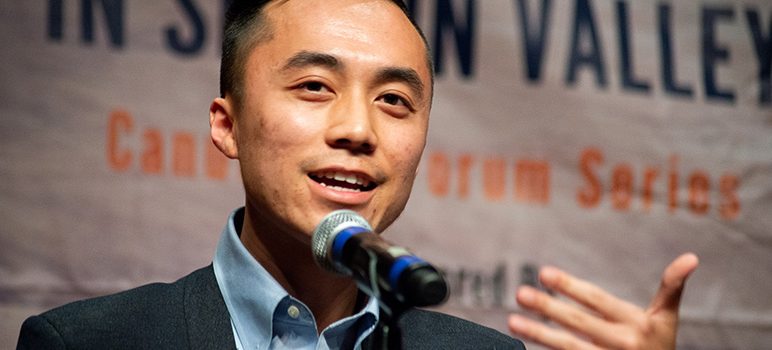Mathew Reed, policy manager for affordable housing advocacy group SV@Home, said he’s excited about AB 387, the Social Housing Act of 2021. “The South Bay has always been the leader on housing issues at the state level, and it’s great to see new energy and a new Assembly member taking on that mantle,” he said. “Right now things aren’t working. We don’t have the resources to meet the needs for affordable housing, and we’re really looking forward to being engaged in the process because we need to be looking for solutions.”[spacer height=”20px”][spacer height=”20px”]
BY: Emanuel Lee┃San Jose Inside
PUBLISHED: February 11, 2021[spacer height=”20px”]
Housing and homelessness is the mainstay issue for California politicians, though every year the state falls further behind on its goals to move the proverbial needle on the issue.
Now one political newcomer is looking beyond the country’s borders for ideas.
California District 25 Assemblyman Alex Lee (D-San Jose) last week introduced AB 387, also known as the Social Housing Act of 2021.
The bill, meant to provide affordable housing for Californians across the income spectrum, would put the state in the development business. The ideal result, according to Lee, would be a slew of mixed-income rentals and even some for-sale homes, perhaps in mixed-use developments with retail, jobs or other amenities.
In America today, the closest thing to social housing is what is known as public housing, or the “housing of last resort,” often in old, crumbling buildings filled only with low-income residents. But in Europe, South America, Asia and elsewhere, the term “social housing” is commonly used to describe state-built homes, generally on publicly owned land, for people of all incomes.
Such developments abroad are typically well-maintained, sometimes overseen by the government, a private company or by the residents themselves. Unlike many affordable housing developments in the U.S. and California, the rents or mortgages aren’t allowed to one day become only market rate.
The aim of AB 387, Lee said, is to address the severe shortage of affordable homes for both low– and moderate–income households.
“There have been similar bills in certain regards to this issue in the past, but nothing like this on this scale,” Lee told San Jose Inside. “I do not believe there has been a social housing effort in California before. That’s what we’re aspiring to be.”
AB 387 is still in its infant stages. It doesn’t yet have a funding mechanism, but Lee expects that and other details to be hammered out by the time it arrives at the Assembly Rules Committee, likely in April. Even so, Mathew Reed, policy manager for affordable housing advocacy group SV@Home, said he’s excited about the proposal.
“The South Bay has always been the leader on housing issues at the state level, and it’s great to see new energy and a new Assembly member taking on that mantle,” he said. “Right now things aren’t working. We don’t have the resources to meet the needs for affordable housing, and we’re really looking forward to being engaged in the process because we need to be looking for solutions.”
Lee said he wants housing programs in Austria and Singapore to be California’s model.
California has set ambitious housing goals of building 200,000 new units a year, yet has been unsuccessful in meeting those goals. In 2018, for instance, 117,000 units were built, but the net gain was just 78,000 homes because of losses to old age, fires and other causes, according to CalMatters.
Even so, Lee said he envisions California leading a national paradigm shift by funding and building social housing.
“Families are increasingly being priced out of the communities they’ve built and are leaving California for more affordable housing markets,” Lee said. “We have an opportunity to reshape how we view housing: not as a commodity, but as a fundamental human right. Social housing is how we provide housing as a human right.”
According to a 2015 California Housing Budget and Policy Center study, more than four in 10 households faced unaffordable housing costs, meaning they pay more than 30 percent of their income on rent or mortgage. More than one in five households statewide spend more than half of their income on housing expenses.
Things haven’t improved since. California ranked 49th among the United States when it comes to housing units per resident as of 2018.
Meanwhile, in Vienna and Singapore, 62 percent and 87 percent of its citizens, respectively, reside in public social housing.
Mortgages offered by Singapore’s Housing and Development Board come with such low monthly payments the homeownership rate is 91 percent across the city-state, despite severe land constraints, and catering to a lower-to-upper-middle-income population.
“Singapore, like California in many ways, is super diverse, super rich, very capitalistic, and they have embraced this program and see a strong need for it,” Lee said.
In Vienna, more than 60 percent of residents live in 440,000 social homes, about half owned directly by the municipal government and the rest by state-subsidized, not-for-profit cooperatives. The city spends nearly one-fifth of its annual budget on social welfare, including subsidized housing.
“A safe and affordable place to live should be a right, not a privilege–and that certainly hasn’t been the case in California,” Assemblywoman Buffy Wicks (D-Oakland) said in a statement. “We need every tool in our toolbox to meet our affordable housing goals, especially as our state begins to recover from the impacts of the Covid-19 pandemic.”
Despite the hurdles, Lee is confident social housing can work in California.
“We have the benefit of learning from the successes of other countries and learning from our mistakes,” he said. “In this country housing programs have been riddled with racist and anti-poor sentiment. That’s a legacy that’s left a reckoning on this country in a lot of ways. This bill is an avenue to being a housing producer and to fill the gaps so more people have access to a greater number of affordable homes.”

